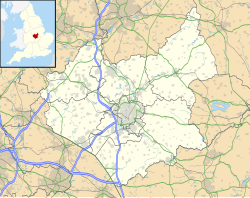| Kirby Bellars Priory | |
|---|---|
| Saint Peter's Parish Church Kirby Bellars | |
 A view of the tower | |
 Kirby Bellars Priory | |
| Country | England |
| Denomination | Anglican |
| History | |
| Founded | Circa eleventh century |
| Architecture | |
| Functional status | Active |
| Administration | |
| Province | Canterbury |
| Diocese | Leicester |
| Benefice | Upper Wreak |
| Clergy | |
| Priest | Canon Michael Britton |
| Monastery information | |
|---|---|
| Other names | Kirkby Bellairs Priory |
| Order | Augustinian Canons Regular |
| Established | 1319-1359 |
| Disestablished | 1536 |
| Dedicated to | Saint Peter |
| Diocese | Diocese of Lincoln |
| Controlled churches |
|
| People | |
| Founder | Sir Roger Beler |
| Site | |
| Location | Leicestershire, England |
| Coordinates | 52°45′30″N0°56′17″W / 52.758245°N 0.93807°W |
| Visible remains | The Parish Church of Saint Peter was formally the Priory Church. There are some earthworks to the north of the churchyard where the priory house once stood. |
| Public access | There is a contact for a key in the church porch. The earthworks can be found nearby. |
Kirby Bellars Priory was a small priory of Canons Regular of Saint Augustine in Leicestershire, England. It is now the Church of England Parish Church of Saint Peter's serving the village of Kirby Bellars.











